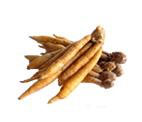


Thai Herbs
Coriander (phak chee)
Coriander has been used in Thai cooking for centuries. The leaves, seeds and even roots can bee used and have independent flavors and are used to garnish, flavor a number of dishes in Thai dishes. The leaves are often chosen for decoration with stem and roots for seasoning. Therapeutic uses including gastrointestinal disorders such as stomach ache, indigestion and nausea.
Tips: How to store fresh herbs such as Basil, coriander, mint, chives, oregano, dill, etc.
1. Trim off the bottom of the stems.
2. Remove excess water from the leaves by using a salad spinner or lying on towels to dry.
3. Place them in a jar of cold water. Change the water and trim the stem every 1-2 days for the best results. Your herbs will stay fresh for over 2 weeks.
4. The wrapping method may be best suited for you: wrap fresh herbs in a wet paper towel and store them in a resealable bag.
5. Place them in your crisper or the door compartment.
6. Prepare for freezing: Remove leaves from stems, clean and dry the herbs.
7. Place in a zip lock bag, spreading the herbs out to a single layer. Lay flat in freezer.
Coriander has been used in Thai cooking for centuries. The leaves, seeds and even roots can bee used and have independent flavors and are used to garnish, flavor a number of dishes in Thai dishes. The leaves are often chosen for decoration with stem and roots for seasoning. Therapeutic uses including gastrointestinal disorders such as stomach ache, indigestion and nausea.
Tips: How to store fresh herbs such as Basil, coriander, mint, chives, oregano, dill, etc.
1. Trim off the bottom of the stems.
2. Remove excess water from the leaves by using a salad spinner or lying on towels to dry.
3. Place them in a jar of cold water. Change the water and trim the stem every 1-2 days for the best results. Your herbs will stay fresh for over 2 weeks.
4. The wrapping method may be best suited for you: wrap fresh herbs in a wet paper towel and store them in a resealable bag.
5. Place them in your crisper or the door compartment.
6. Prepare for freezing: Remove leaves from stems, clean and dry the herbs.
7. Place in a zip lock bag, spreading the herbs out to a single layer. Lay flat in freezer.
Essential Thai Herbs and Spices Used in Thai cooking
: Thai cooking is an art in Thailand need skill and time to prepare the combination of all ingredients for the exact balance of Thai flavors.
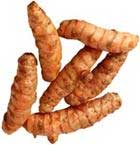
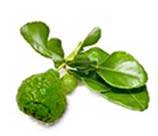
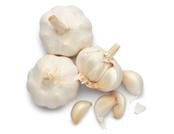
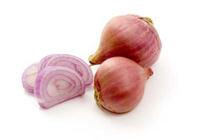



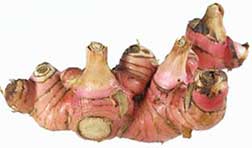
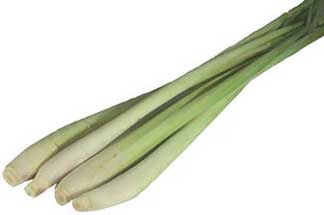
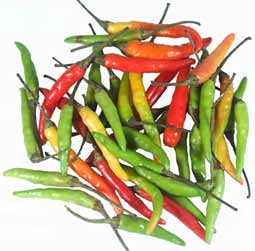
Galangal (Khaa)
Galangal is a plant in the ginger family, has a soapy, earthy aroma and a pine-like flavour with a faint hint of citrus. Its refreshing fragrance is often used in many Thai dishes to balance the taste. The roots have many medicinal uses to improve digestion, relieve heartburn, improve blood circulation, and improve skin complexion. Young galangal is less spicy than older roots. Tips : To store fresh galangal: wrap the whole galangal in paper towel and place in a plastic bag in the refrigerator keep for 10-14 days. To Freeze fresh galangal: wash and slice the galangal into small pieces, let it dry and place in fridge, keep them seperate not on top of each other.
Galangal is a plant in the ginger family, has a soapy, earthy aroma and a pine-like flavour with a faint hint of citrus. Its refreshing fragrance is often used in many Thai dishes to balance the taste. The roots have many medicinal uses to improve digestion, relieve heartburn, improve blood circulation, and improve skin complexion. Young galangal is less spicy than older roots. Tips : To store fresh galangal: wrap the whole galangal in paper towel and place in a plastic bag in the refrigerator keep for 10-14 days. To Freeze fresh galangal: wash and slice the galangal into small pieces, let it dry and place in fridge, keep them seperate not on top of each other.
Ginger (Khing)
Ginger is an herb, used in Thai cooking. The rhizome (underground stem) is used as a spice and also as a medicine. Ginger is particularly useful in reducing inflammation and helps relieve nausea and in some studies has shown promise as an anticancer agent. It can be used fresh, dried and powdered.
Tips: How to store ginger: Choose the freshest ginger: To find the freshest ginger, look for ginger with a fresh and spicy fragrance and a nice smooth skin. Avoid any ginger that is wet moist or mouldy. To store ginger in a zipper storage bag, take the unpeeled ginger and place in a zipper bag, push all the air out of the bag. Place in the veggie crisper in your fridge and keep it for several weeks.
Ginger is an herb, used in Thai cooking. The rhizome (underground stem) is used as a spice and also as a medicine. Ginger is particularly useful in reducing inflammation and helps relieve nausea and in some studies has shown promise as an anticancer agent. It can be used fresh, dried and powdered.
Tips: How to store ginger: Choose the freshest ginger: To find the freshest ginger, look for ginger with a fresh and spicy fragrance and a nice smooth skin. Avoid any ginger that is wet moist or mouldy. To store ginger in a zipper storage bag, take the unpeeled ginger and place in a zipper bag, push all the air out of the bag. Place in the veggie crisper in your fridge and keep it for several weeks.
Lemon Grass (Ta Khrai)
Lemongrass is an essential ingredient in Thai cooking Lemon Grass is widely popular for its citrus scent and flavour and also knows as herbal medicine for gastro intestinal problems stomachaches, diarrhea, gas, bowel spasms, vomiting, fever, the flu and headaches.
Tips: How to store fresh lemongrass: Choose the fresh lemongrass: Look for fresh lemongrass stalks firm and heavy, with no bruising. To store fresh: wrap in a paper towel and place in a plastic bag put in the refrigerator, keep it for 10-14 days. To freeze: wash, trim and chopped the lemongrass, let it dry, then place in a freezer bag put in the freezer, keep for 4-6 months.
Lemongrass is an essential ingredient in Thai cooking Lemon Grass is widely popular for its citrus scent and flavour and also knows as herbal medicine for gastro intestinal problems stomachaches, diarrhea, gas, bowel spasms, vomiting, fever, the flu and headaches.
Tips: How to store fresh lemongrass: Choose the fresh lemongrass: Look for fresh lemongrass stalks firm and heavy, with no bruising. To store fresh: wrap in a paper towel and place in a plastic bag put in the refrigerator, keep it for 10-14 days. To freeze: wash, trim and chopped the lemongrass, let it dry, then place in a freezer bag put in the freezer, keep for 4-6 months.
Kaffir Lime (Ma Krood)
Traditionally, Kaffir Lime leaves are utilized for various medical and culinary. Karffir lime leaves are absolutely essential for Thai cooking. They are used in everything, from soups to salads to curries and stir fries. The zest from fruit is added to curry paste and give Thai food its unique citrus flavour and for medicinal uses beneficial for digestion and for blood. The citrus juice used to be included in Thai ointments and shampoos.
Tips: How to store Kaffir lime leaves: To store fresh kaffir lime leaves: Wash the leaves and dry them with paper towel. Place in a plastic bag or container in the fridge for several weeks. To Freeze: Place in a freezer bag or an airtight container and store in the freezer for up to 12 months and still retain their flavour.
Traditionally, Kaffir Lime leaves are utilized for various medical and culinary. Karffir lime leaves are absolutely essential for Thai cooking. They are used in everything, from soups to salads to curries and stir fries. The zest from fruit is added to curry paste and give Thai food its unique citrus flavour and for medicinal uses beneficial for digestion and for blood. The citrus juice used to be included in Thai ointments and shampoos.
Tips: How to store Kaffir lime leaves: To store fresh kaffir lime leaves: Wash the leaves and dry them with paper towel. Place in a plastic bag or container in the fridge for several weeks. To Freeze: Place in a freezer bag or an airtight container and store in the freezer for up to 12 months and still retain their flavour.
Turmeric (Kha min)
Turmeric is a rhizome with bright yellow-orange flesh and a tough brown skin. It has a peppery, warm and bitter flavor with a mild fragrance use in Thai curry provides yellow coloring. Turmeric in medicinal is use for digestive disorders, liver diseases, cancer, atherosclerosis, osteoarthritis, menstrual problems, Alzheimer's disease, obesity, psoriasis, bacterial infection and eye disorder.
Turmeric is a rhizome with bright yellow-orange flesh and a tough brown skin. It has a peppery, warm and bitter flavor with a mild fragrance use in Thai curry provides yellow coloring. Turmeric in medicinal is use for digestive disorders, liver diseases, cancer, atherosclerosis, osteoarthritis, menstrual problems, Alzheimer's disease, obesity, psoriasis, bacterial infection and eye disorder.
Krachai
Krachai is annual plant with aromatic rhizomes and a yellow-brown root is used as a flavoring. It has tube shape and brown skin with milder flavour than ginger and galangal. Thai krachai is a useful herbal addition to Thai curry and soups. Therapeutic benefits include: stomachache relieving and antimicrobial properties anti tussive and ant flatulence agent.
Tips: how to store turmeric and Krachai: Store in cool, dark cupboard, away from direct heat or sunlight in containers with tightly fitting lids. Fresh turmeric or Krachai unpeeled: wrap in a paper towel and place in a zip plastic bag can store in the refrigerator for up to 3 weeks.
Krachai is annual plant with aromatic rhizomes and a yellow-brown root is used as a flavoring. It has tube shape and brown skin with milder flavour than ginger and galangal. Thai krachai is a useful herbal addition to Thai curry and soups. Therapeutic benefits include: stomachache relieving and antimicrobial properties anti tussive and ant flatulence agent.
Tips: how to store turmeric and Krachai: Store in cool, dark cupboard, away from direct heat or sunlight in containers with tightly fitting lids. Fresh turmeric or Krachai unpeeled: wrap in a paper towel and place in a zip plastic bag can store in the refrigerator for up to 3 weeks.
Garlic (Kra Tiem)
Garlic is an annual herbaceous plant with underground bulbs comprising several cloves. Dried mature bulbs are used as a flavoring and condiment in Thai cuisine. Garlic is good in relieving gas and aids digestion. Also reduces blood sugar and cholesterol; and is packed with vitamins and minerals.
Garlic is an annual herbaceous plant with underground bulbs comprising several cloves. Dried mature bulbs are used as a flavoring and condiment in Thai cuisine. Garlic is good in relieving gas and aids digestion. Also reduces blood sugar and cholesterol; and is packed with vitamins and minerals.
Shallot(Hom Daeng)
Shallots, or small red onions, are annual herbaceous plants. Underground bulbs comprise garlic-like cloves. Shallot bulbs contain a volatile oil, and are used as flavouring or seasoning agents. Therapeutic properties include the alleviation of stomach discomfort and know as an antiemetic, antidiarrhea, expectorant, antitussive, diuretic and antiflu agents.
Tips: how to store garlic and shallot: The best way to store garlic or shallot in a cool room temperature. Do not refrigerating it causes the bulb to deteriorate: Freezing is not recommended, because it changes the consistency and flavour.
Shallots, or small red onions, are annual herbaceous plants. Underground bulbs comprise garlic-like cloves. Shallot bulbs contain a volatile oil, and are used as flavouring or seasoning agents. Therapeutic properties include the alleviation of stomach discomfort and know as an antiemetic, antidiarrhea, expectorant, antitussive, diuretic and antiflu agents.
Tips: how to store garlic and shallot: The best way to store garlic or shallot in a cool room temperature. Do not refrigerating it causes the bulb to deteriorate: Freezing is not recommended, because it changes the consistency and flavour.
Chili (Prik)
Chili is used as garnishing and flavoring in Thai dishes, as a general rule, the smaller the chili, the hotter it is. There are many types of chilies grown in Thailand such as Prick Khee Noo (which is the tiniest and hottest one), followed by the slightly larger Phrik Chi Fa. Dried chilies or Chili flakes and ground chili powder are also used. Chili is a wonderful herb that creates appetite, relieves gas, and aids digestion. It is also packed with various vitamins and minerals.
Tips: how to store fresh chilies: Refrigerating: fresh unwashed chilies wrapped in a paper towels or in a ventilated plastic bag in the fridge, can be stored for up to 3 weeks. In the freezer: wash in clean water, spread chilies out on a flat surface and cover with a cloth and leave to dry completely. Lay chilies flat in a single layer in a plastic bag push the air out of the bag as possible before sealing and then place in the freezer.
Chili is used as garnishing and flavoring in Thai dishes, as a general rule, the smaller the chili, the hotter it is. There are many types of chilies grown in Thailand such as Prick Khee Noo (which is the tiniest and hottest one), followed by the slightly larger Phrik Chi Fa. Dried chilies or Chili flakes and ground chili powder are also used. Chili is a wonderful herb that creates appetite, relieves gas, and aids digestion. It is also packed with various vitamins and minerals.
Tips: how to store fresh chilies: Refrigerating: fresh unwashed chilies wrapped in a paper towels or in a ventilated plastic bag in the fridge, can be stored for up to 3 weeks. In the freezer: wash in clean water, spread chilies out on a flat surface and cover with a cloth and leave to dry completely. Lay chilies flat in a single layer in a plastic bag push the air out of the bag as possible before sealing and then place in the freezer.
Thai Basil
Basil is an annual herbaceous plant, the fresh leaves of which are either eaten raw or used as a flavoring in Thai cooking. Three different varieties are used. The most common is Bai Horapha, which has a slight aniseed flavour and a reddish purple colour. Others are Bai Kaphrao, which has hotter flavour, and Bai Maenglnk, a milder form often sprinkled over soups and salads. Therapeutic properties are as carminative, diaphoretic, expectorant, digestant and stomachic agents.
Basil is an annual herbaceous plant, the fresh leaves of which are either eaten raw or used as a flavoring in Thai cooking. Three different varieties are used. The most common is Bai Horapha, which has a slight aniseed flavour and a reddish purple colour. Others are Bai Kaphrao, which has hotter flavour, and Bai Maenglnk, a milder form often sprinkled over soups and salads. Therapeutic properties are as carminative, diaphoretic, expectorant, digestant and stomachic agents.
Mint (Bai sara nea)
Mints are aromatic, almost exclusively perennial, and rarely annual; herbs. The fresh leaves of this herbaceous plant are used as a flavoring and eaten raw in Thai cuisine. Therapeutic uses, including: carminative, mild antiseptic, local anesthetic, diaphoretic and digesting.
Mints are aromatic, almost exclusively perennial, and rarely annual; herbs. The fresh leaves of this herbaceous plant are used as a flavoring and eaten raw in Thai cuisine. Therapeutic uses, including: carminative, mild antiseptic, local anesthetic, diaphoretic and digesting.
